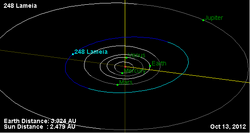Astronomy:248 Lameia
 Orbital diagram | |
| Discovery | |
|---|---|
| Discovered by | Johann Palisa |
| Discovery date | 5 June 1885 |
| Designations | |
| (248) Lameia | |
| Pronunciation | /ləˈmiːə/[1] |
| Named after | Lamia |
| A885 LA, 1959 LO | |
| Minor planet category | Main belt |
| Orbital characteristics[2] | |
| Epoch 31 July 2016 (JD 2457600.5) | |
| Uncertainty parameter 0 | |
| Observation arc | 130.86 yr (47,796 d) |
| |{{{apsis}}}|helion}} | 2.64 astronomical unit|AU (394.30 Gm) |
| |{{{apsis}}}|helion}} | 2.31 AU (345.06 Gm) |
| 2.47 AU (369.67 Gm) | |
| Eccentricity | 0.066588 |
| Orbital period | 3.88 yr (1,418.9 d) |
| Average Orbital speed | 18.95 km/s |
| Mean anomaly | 264.207° |
| Mean motion | 0° 15m 13.392s / day |
| Inclination | 4.0581° |
| Longitude of ascending node | 246.845° |
| 10.782° | |
| Physical characteristics | |
| Dimensions | 48.66±2.5 km[3] |
| Rotation period | 11.912 h (0.4963 d) |
| Geometric albedo | 0.0615±0.007 |
| Absolute magnitude (H) | 10.2 |
Lameia (minor planet designation: 248 Lameia) is a typical main belt asteroid. It was discovered by Austrian astronomer Johann Palisa on 5 June 1885 in Vienna and was named after the Lamia, a lover of Zeus in Ancient Greek mythology. 248 Lameia is orbiting the Sun with a period of 3.88 years and a low eccentricity (ovalness) of 0.067.[2] The semimajor axis of 2.47 astronomical unit|AU is slightly inward from the 3:1 Kirkwood Gap.[4] Its orbital plane is inclined by 4° to the plane of the ecliptic.[2]
On 27 June 1998 an occultation of the 8th magnitude star PPM 236753 (HD 188960)[5] by 248 Lameia was timed by five observers near Gauteng, South Africa . The chords produced a rough size estimate of a 62 × 53 km ellipse.[6] The size estimate based on IRAS Minor Planet Survey data is ~49 km. The rotation rate of this object is commensurate with the rotation of the Earth, requiring observations from different locations to build a complete light curve. These yield a rotation estimate of 11.912±0.001 h with a brightness variation of 0.17±0.01 magnitude in amplitude. The same data set gives a size estimate of 47±3 km, in agreement with earlier measurements.[3]
Infrared imaging of this body shows a relatively featureless spectra that suggests materials that are similar to carbonaceous chondrite meteorites.[7]
References
- ↑ 'Lamea' in Noah Webster (1884) A Practical Dictionary of the English Language
- ↑ 2.0 2.1 2.2 "248 Lameia". JPL Small-Body Database. NASA/Jet Propulsion Laboratory. https://ssd.jpl.nasa.gov/sbdb.cgi?sstr=248;cad=1.
- ↑ 3.0 3.1 Pilcher, Frederick et al. (April 2015). "Rotation Period and H-G Parameters Determination for 248 Lameia". Bulletin of the Minor Planets Section of the Association of Lunar and Planetary Observers 42 (2): 137–139. Bibcode: 2015MPBu...42..137P.
- ↑ Saha, Prasenjit (December 1992). "Simulating the 3:1 Kirkwood gap". Icarus 100 (2): 434–439. doi:10.1016/0019-1035(92)90109-K. Bibcode: 1992Icar..100..434S.
- ↑ "HD 188960". SIMBAD. Centre de données astronomiques de Strasbourg. http://simbad.u-strasbg.fr/simbad/sim-basic?Ident=HD+188960.
- ↑ Fraser, B.; Overbeek, M. D. (1998). "Occultation Observation of PPM 236753 by 248 Lameia, 1998 June 27". Monthly Notes of the Astronomical Society of Southern Africa 57: 85. Bibcode: 1998MNSSA..57...85F.
- ↑ Fieber-Beyer, Sherry K.; Gaffey, Michael J. (September 2015). "Near-infrared spectroscopy of 3:1 Kirkwood Gap asteroids III". Icarus 257: 113–125. doi:10.1016/j.icarus.2015.04.034. Bibcode: 2015Icar..257..113F.
External links
- The Asteroid Orbital Elements Database
- Minor Planet Discovery Circumstances
- Asteroid Lightcurve Data File
- 248 Lameia at AstDyS-2, Asteroids—Dynamic Site
- 248 Lameia at the JPL Small-Body Database
 |

